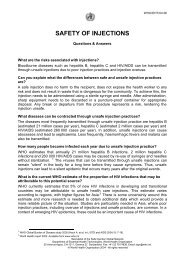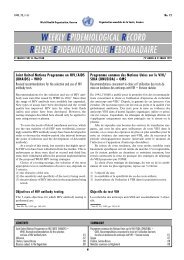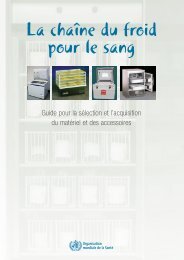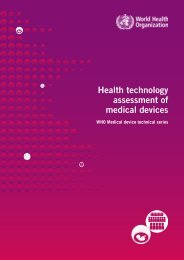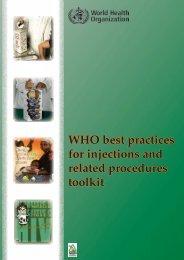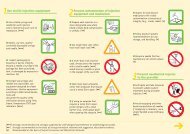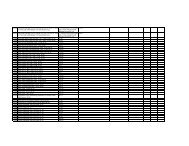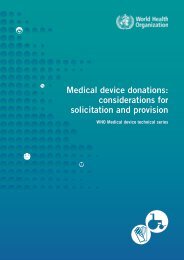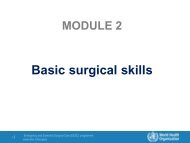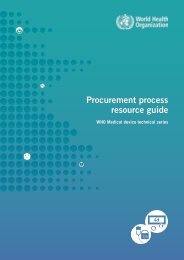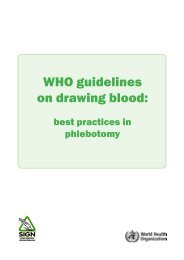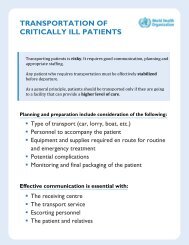SIGN meeting report 2003. - World Health Organization
SIGN meeting report 2003. - World Health Organization
SIGN meeting report 2003. - World Health Organization
You also want an ePaper? Increase the reach of your titles
YUMPU automatically turns print PDFs into web optimized ePapers that Google loves.
Introduction<br />
Objectives and expected results<br />
5<br />
Evelyn Isaacs<br />
WHO, AFRO, Harare<br />
The objectives of the pre-conference satellite <strong>meeting</strong> on infection control, including<br />
injection safety were to:<br />
1. Exchange information with participants of the Safe Injection Global Network<br />
(<strong>SIGN</strong>) and HIV/ AIDS programme managers on Infection Prevention and Control<br />
(IPC);<br />
2. Encourage countries in sub-Saharan Africa to address infection control including<br />
safe and appropriate use of injections in their prevention and care initiatives;<br />
3. Brief programme managers and other stakeholders actively involved in HIV<br />
prevention and care programmes in sub-Saharan Africa on the simple steps to<br />
prevent nosocomial infections particularly HIV/AIDS through (a) infection control<br />
and (b) safe and appropriate use of injections.<br />
Challenges in infection prevention and control<br />
Emil Asamoah-Odei<br />
WHO, AFRO, Harare<br />
This <strong>meeting</strong> was unique, in that for the first time, it brought together safe injection<br />
programmes and HIV/AIDS programmes and that it addressed not only injection<br />
safety but also broader infection control issues.<br />
The modes of transmission of HIV in health care settings are now well identified<br />
In health care settings, HIV may be transmitted to (a) patients through transfusion of<br />
HIV infected blood, unsafe injections, reuse of contaminated instruments or needles and<br />
to (b) health care workers through injuries from needles or other instruments and<br />
splashes. Infection can also be acquired following a contact with an infected health care<br />
worker, although this is less common. The UNGASS Declaration of June 2001 called for<br />
the implementation of universal precautions in health care settings to prevent<br />
transmission of HIV infection by 2003 and to implement a wide range of prevention<br />
programmes by 2005, including provision of sterile injecting equipment and safe blood<br />
supply.<br />
Weak health systems facilitate health care- associated HIV infections<br />
Factors that facilitate the spread of HIV in health care settings include inadequate blood<br />
transfusion services, the lack of infection control policies, guidelines and training, the<br />
lack of Infection Control Committees, inadequate availability of equipment and<br />
supplies and the lack of monitoring systems. In addition, often, health care workers lack<br />
knowledge, have inappropriate attitudes towards infection control and engage in<br />
behaviours that may expose their patients to risks. Finally, there is an excessive<br />
consumer and provider demand for injections.<br />
The challenges to meet to prevent HIV infection in health care settings<br />
Together with other programmes (e.g., viral hepatitis prevention programmes), HIV<br />
prevention and care programmes are faced with the challenges of expanding safe blood<br />
transfusion services, developing infection prevention and control policies, coordinating<br />
institutions and mechanisms, developing human resource capacity, introducing new<br />
technologies, mobilizing resources, strengthening surveillance, intensifying public



